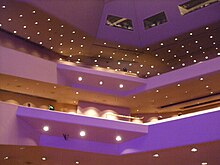 | |
 | |
| Address | South Sherwood Street Nottingham England |
|---|---|
| Owner | Nottingham City Council |
| Type | Concert Hall/Auditorium |
| Capacity | 2,499 (3 levels) |
| Current use | Touring Venue |
| Construction | |
| Opened | 27 November 1982 |
| Years active | Since 1982 |
| Architect | RHWL (Renton Howard Wood Levin Partnership) |
| Website | |
| http://www.trch.co.uk | |


Nottingham Royal Concert Hall is a concert hall in the English city of Nottingham. It is owned by Nottingham City Council and is part of a complex that also includes the city's Theatre Royal. The Royal Concert Hall's striking modern architecture has proved to be a city landmark at the heart of Nottingham City Centre, opposite the more recently built The Cornerhouse complex.
The concert hall is served by the adjacent Royal Centre tram stop on the Nottingham Express Transit.
History
The site of the Royal Concert Hall was previously the old 'Empire Palace of Varieties' designed and built in 1898 by Frank Matcham. The Empire closed for the last time in 1958 and was demolished for road-widening in 1969.
Designed by the Renton Howard Wood Levin Partnership (architects of the Sheffield Crucible Theatre and Manchester's Bridgewater Hall), the hall cost £12 million to complete. The project's client was Nottingham City Council.
Work on the Royal Concert Hall began in 1980 and was completed in 1982, providing Nottingham with a contemporary 2,499-seater auditorium. The first artist to perform there was Elton John in November 1982.
See also
References
- ^ "General Information - History". The Royal Centre. Archived from the original on 29 September 2010. Retrieved 18 October 2010.
- "Nottingham Express Transit : Tram Stops : Royal Centre". TheTrams.co.uk. Retrieved 18 August 2015.
- "About Us". Nottingham City Council. Retrieved 9 August 2016.
External links
- Official website
- Exterior photograph
- Interior photograph
- See the Royal Concert Hall on Google Street View
52°57′20″N 1°9′5″W / 52.95556°N 1.15139°W / 52.95556; -1.15139
| Places of interest in Nottingham | ||
|---|---|---|
| Historic buildings |
|  |
| Public Houses | ||
| Museums, centres and galleries | ||
| Parks and public spaces | ||
| Theatre and entertainment | ||
| Shopping | ||
| Transport | ||
| Education | ||
| Sport | ||
| Lost landmarks | ||